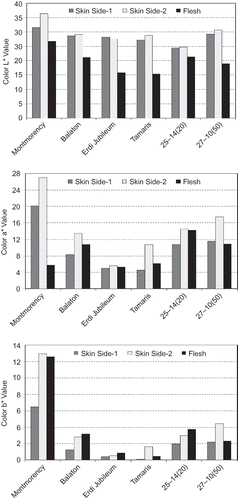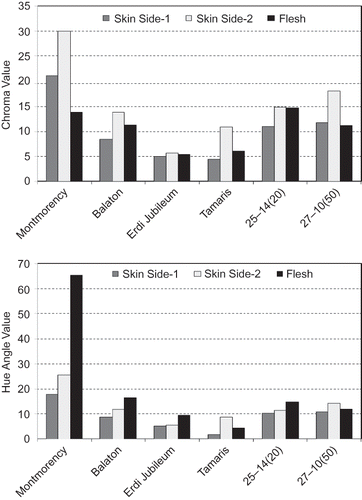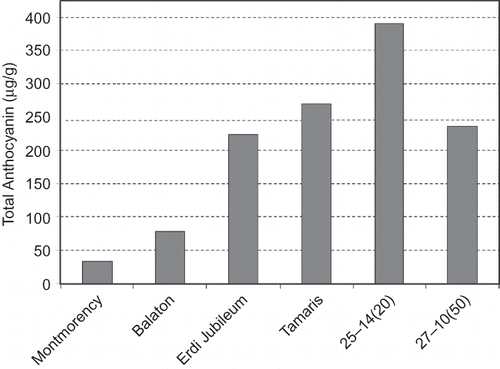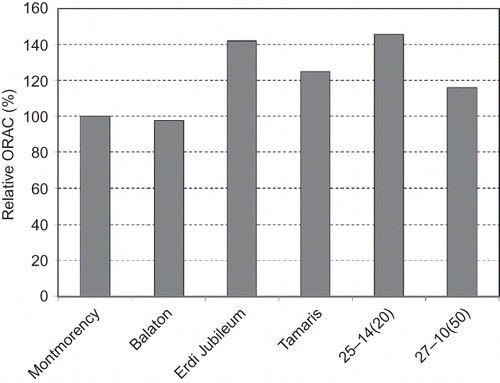Abstract
Tart cherries (Prunus cerasus L.) are rich in anthocyanins and possess high antioxidant activity. The objective of this study was to evaluate six Michigan tart cherry selections for different quality attributes; fruit weight, firmness, total soluble solids (TSS), titratable acidity, instrumental color parameters, total anthocyanins, and antioxidant capacity, determined as Oxygen Radical Absorbance Capacity (ORAC). Generally, significant (p < 0.01) differences were observed across tart cherry selections for fruit weight, firmness, total soluble solids, titratable acidity, and color values. As compared to 13.7°B for Montmorency (control), the TSS contents of all the tart cherry selections were significantly higher; ranging from 15.8 °B in selection 27–10(50) to 20.2°B in Erdi Jubileum. Fruit weight also showed significant differences, which were in the range of 3.95–8.17 g/fruit. In comparison to Montmorency, other tart cherry selections showed significantly higher titratable acidity (1.20–1.41% vs. 1.132%); higher anthocyanins (78.9–391.4 μg/g vs. 33.1 μg/g, as gallic acid equivalent); and higher ORAC values (up to 145.4% more). With respect to cost and better marketability, the results of this study could be useful for the cherry juice/concentrate industry.
INTRODUCTION
Michigan is the leading producer of tart cherries (Prunus cerasus L.) in the U.S., with a share of the total production that often exceeds 75% of total U.S. output.[Citation1] The National Agricultural Statistics Service reported Michigan tart cherry production at 266 million pounds for 2009 which was bizhigher than the previous year[Citation2]; however, 2010 estimates were lower than the 2009 production. Cherries, in addition to being an important contributor to state's agriculture and food system, are of critical importance in meeting the U.S. demand for this commodity. Processing, manufacturing, and distribution of cherry and cherry products add additional income and employment to the state. Moreover, production of tart cherries also contributes to tourism revenue for the state.
Anthocyanins, one of the major groups of pigments, are responsible for the orange, red, and blue colors in fruits, vegetables, flowers, and other storage tissues in plants. Their presence is universally associated with attractive, colorful, and flavorful fruits.[Citation3] As compared to other berries, tart cherries contain the highest amount of anthocyanins,[Citation4,Citation5] which are a major contributor to the cherries' antioxidant capacity, commonly referred to as ORAC (Oxygen Radical Absorbance Capacity). The other physicochemical characteristics, such as fruit weight, color, acidity, and firmness, are important quality atributes of cherries that have been studied previously.[Citation6]
The health benefits of cherries have been well documented; cherries are reported to be rich in many phytochemicals components, such as flavonoids and phenolic compounds, which provide protection against chronic diseases through multiple effects, including the antioxidant effect.[Citation5,Citation7,Citation8] Research has shown that the anthocyanins, acting primarily as antioxidants, have anti-inflammatory, anti-carcinogenic, and anti-aging properties.[Citation9] In addition, it has been shown that antioxidants can significantly improve certain immune responses.[Citation10] These beneficial effects may be partially associated with the abundance of anthocyanins, such as the glycosides of cyanidin. These potential health benefits of phenolic compounds having antioxidant properties have generated a significant interest in their non-traditional uses or exploration of new sources—e.g., yogurt with added cherry paste; [Citation11] use of phenolic extracts in fruit juices[Citation12]; and phenolics in white mulberry.[Citation13]
With the increased consumer awareness of the many benefits of consuming cherries or processed cherry products, production and marketing of cherry juice concentrate has grown consistently. The use of cherry juice concentrate also has been gaining support in functional foods as its nutraceutical potential is just beginning to be understood. Michigan State University (MSU) has an extensive tart cherry variety development program to enhance productions and extend harvest season by developing early- and late-season cultivars with higher anthocyanin content and antioxidant potential. tart cherry, grown primarily for processing (frozen, brined, canned, dried, etc.), in the U.S. is dominated by the red-skinned, clear juice variety ‘Montmorency’[Citation14] but other promising selections are being bred at MSU, too. The main objective of the present study was to evaluate some new tart cherry selections for their physico-chemical quality, total anthocyanins, and antioxidant capacity. The results reported in this study have significance for the Tart cherry growers and processors.
MATERIALS AND METHODS
Six tart cherry selections grown at the Michigan State University's Clarksville Horticulture Experiment Station (Clarksville, Michigan, USA) were harvested at optimum maturity, which was based on fruit maturity and color development; these selections included: Montmorency, Balaton, Erdi Jubileum, Tamaris, 25-14(20), and 27-10(50). Montmorency, which is the most popular of the sour cherry varieties the U.S., was used as control. All the analyses related to the whole fruit were completed within 24 h of harvesting to have a minimal effect resulting from postharvest changes. For pH, titratable acidity, total anthocyanins, and ORAC determination, cherries were pitted manually, mashed using a Waring blender and the resulting macerate stored in glass bottles at −20°C until analyzed.
Fruit Weight, Total Soluble Solids, pH, and Titratable Acidity
The fruit weight was measured using a digital weighing scale, and reported in g/fruit as mean of 10 fruits. The analysis of total soluble solids, pH, and titratable acidity was done in triplicate. The pH was measured using a Corning-430 pH meter (Corning, Inc., Corning, NY, USA) after calibration with standard pH buffer (pH 4, 7, and 10). Total soluble solids were measured using an Abbe 3-L refractometer (Bausch & Lomb Optical Co., Rochester, NY, USA) and reported as °Brix. Titratable acidity was measured by mixing 10 g of well-mixed cherry macerate to 100 mL of distilled water. The mixture was then titrated to a final pH of 8.0 using 0.1N NaOH solution. The titratable acidity, expressed as % malic acid, was calculated using the following equation: % malic acid = mL 0.1N NaOH x N NaOH x 0.067 meq x (100/wt. of sample).
Fruit Firmness
Tart cherry firmness was measured using a Stable Micro Systems texture analyzer (Model: TA-XT2i, Texture Technologies, Scarsdale, NY, USA), equipped with a 500-N load cell. A conical penetration probe was used to penetrate the fruit and the force required was reported in Newtons (N-force). Testing parameters used were a cross-head speed of 1 mm/sec and a penetration depth of 5 mm.[Citation15] Firmness values reported are mean of 10 measurements for different fruits.
Fruit Color (Skin and Flesh)
Three different types of cherry color measurements were done: skin side-1 (dark side), skin side-2 (light color), and fruit flesh. Color was assessed by tristimulus reflectance colorimetry, using Minolta Chromameter (Konica Minolta Co., Osaka, Japan). Color values were recorded as CIE L* (0, black; 100, white), a* (–a, greenness; +a, redness), and b* (– b, blueness; +b, yellowness). The colorimeter was calibrated using a white reflectance plate (L* = 98.9, a* = 0.44, and b* = 0.30). Data reported represent mean of 10 measurements. The data thus obtained was used to calculate the Chroma and Hue Angle according to method of Little[Citation16] as follows:
Total Anthocyanins
The total Anthocyanins were measured using the method of Siddiq et al.[Citation17] The mashed cherry samples were diluted with 0.025M citrate buffer (pH, 4.5). The total anthocyanins were extracted by adding 1mL of the diluted sample to 9 mL of 85:15 ethanol and 1.5N HCl. The mixture was stirred using a magnetic stirrer for 3 min, allowed to sit at room temperature for 1 h and then the absorbance readings were taken at a wavelength of 535 nm. The absorbance readings were measured in 4-mL disposable cuvettes using Spectronic-21D spectrophotometer (Milton Roy, Ivyland, PA, USA).
Antioxidant Capacity (ORAC)
The antioxidant capacity of cherries was determined as Oxygen Radical Absorbance Capacity (ORAC). The ORAC assay was performed using fluorescein method of Huang et al.,[Citation18] with some modifications.[Citation19] The equipment used for this analysis was BioTek FL×800 Multi-Detection Microplate Reader (Biotek Instruments, Winooski, Vermont, USA). The ORAC values were computed from the raw data using the method of Cao et al.,[Citation20] results for which are generally expressed as Trolox equivalent (TE) – μm TE/g sample. The data is reported as % relative ORAC in comparison to Montmorency cultivar as 100% ORAC value.
Statistical Analysis
All the data was statistically analyzed using one-way analysis of variance. The separation of means or significant difference comparisons was done at a statistical significance level of P < 0.01. Data represents mean values of triplicate or ten replicates as noted under respective analytical methods.
RESULTS AND DISCUSSION
Fruit Weight, Fruit Firmness, Total Soluble Solids, pH, and Titratable Acidity
The results of fruit weight, firmness, total soluble solids (TSS), pH, and titratable acidity are shown in . The fruit weight had a wide range across tart cherry selections, from 3.95 g/fruit for 25-14(20) to 8.17 g/fruit for Balaton. With the exception of Tamaris and 27-10(50), the rest of selections differed significantly as compared to control or Montmorency cultivar. Variations in fruit weight among different cultivars of the same fruit have been previously investigated;[Citation21] that study reported a fruit weight range of 8.8 g to 14.5 g in sweet cherries. From the processing perspective, fruit with relatively higher weight would be better as it would result in reduced solid waste (mainly pits) per ton cherries processed.
Table 1 Fruit weight, fruit firmness, total soluble solids, pH, and titratable acidity of Michigan tart cherry selections
As compared to Montmorency (13.74°B), the TSS contents for all the tart cherry selections were significantly higher; ranging from 15.8°B in 27-10(50) to 20.2°B in Erdi Jubileum. The variations in soluble solids contents are not uncommon. In an earlier study, a soluble solid range of from 13.5°B-24.5°B was reported.[Citation21] Another study reported a range of 14.43°B to 18.38°B.[Citation6] The higher TSS contents offer a processing benefit especially when cherry juice concentrate is to be made. The cherry juice with a higher TSS level as a starting material would save time and energy resulting in lower processing costs for the cherry concentrate industry. In addition, the reduced exposure to processing temperatures in juice concentration operations would result in lower loss of both anthocyanins and other antioxidants, thus a better final ORAC value. It would be interesting to study as to how much time and energy can be saved in such concentration operations if the starting juice had a higher TSS content.
The pH values for all cherry selections, which ranged from 3.28 in Montmorency to 3.36 in both 25-14(20) and 27-10(50) selections, had no significant differences. Contrary to the results of present study, variations in pH of different cherry cultivars have been reported.[Citation6] The titratable acidity values, reported as % malic acid equivalent, differed significantly as compared to Montmorency. The titratable acidity values ranged from a low of 1.132 % in Montmorency to a high of 1.410% in Erdi Jubileum. Since acidity of foods is one of the major contributors to the flavor of a product, the differences in the acid levels can result in noticeable variations in the sensory profile of the final prepared products.
Tart cherry fruit firmness, with the exception of selections 25-14(20) and 27-10(50) showed significant differences when compared to Montmorency cherries. The highest firmness was observed in case of Balaton cherries (0.77 N), whereas Montmorency recorded the lowest firmness value of 0.52 N. Since a conical probe was used to penetrate the skin and record the data, these firmness values are somewhat lower than if a compression test was used where whole cherry is pressed to determine firmness. The firmness of cherries can be measured by different methods, such as deformation, extrusion and puncture tests.[Citation22] In the present study, a penetrating probe was used to measure skin puncture force, which is of significance in tart juice extraction process. Fruit weight of cherries appeared to influence the firmness; the tart cherry selections with higher fruit weight tended to exhibit relatively higher firmness.
Fruit Skin and Flesh Color (L*, a*, b*, Chroma, and Hue Angle)
Instrumental color L*, a*, b* values are shown in . The cherry skin side-1 L* values, which represent lightness, ranged from 24.54 in 25-14(20) to 31.32 in Montmorency. The skin side-2 L* values, which were higher than skin side-1 lightness, showed a wider range, from 24.71 to 36.32 for the same two selections for side-1, respectively. The L* values for the fruit flesh (15.50–26.69) were consistently lower than either side-1 or side-2 values, with Montmorency having the highest and Tamaris with the lowest L* values.
A mixed trend was observed for instrumental color a* and b* values across tart cherry selections; one exception being the Montmorency, which had significantly higher a* and b* values, which was true for both the skin and flesh color. The total anthocyanins and phenolics contents have a considerable influence on fruit or flesh color[Citation6]; the concentration of these compounds is significantly higher in the fruit skin than the flesh. For maximization of anthocyanins and phenolic compounds during juice extraction, use of cellulytic and pectinase enzymes is common in the juice processing industry. Moreover, the use of such enzymes results in higher juice yields.[Citation23]
While instrumental color L*, a*, and b* values give an estimate of lightness, redness or yellowness, computation of chroma and hue angle, which is computed from a* and b* coordinates data, gives a more reliable comparison and interpretation of color data. Chroma represents “richness of color” or color intensity and hue angle depicts how an average person will perceive that color. The chroma and hue angle values of tart cherry selections are given in .
Montmorency had higher chroma and hue angle values as compared to all other cherry selections studied. The lowest chroma values, except the skin side-1 and flesh color were observed in Erdi Jubileum. The lowest hue angle values were observed for Tamaris skin side-1 and flesh, whereas skin side-2 in Erdi Jubileum exhibited the lowest hue. Overall, no clear pattern was observed as the data for chroma and hue showed mixed trend across tart cherry selections.
Total Anthocyanins
Natural pigments like anthocyanins are regarded as an indicator of tart cherry quality.[Citation24] The results in this study showed that Montmorency cherries had significantly lower total anthocyanins as compared to all other tart cherry selections studied (). Selection 25-14(20) had the highest total anthocyanin content (391.37 μg/g gallic acid equivalent), which were almost 12 times of that observed in Montmorency (33.08 μg/g). Our findings are similar to those reported by Chandra et al.,[Citation3] where different tart cherry selections they studied showed approximately 5–16 times more total anthocyanin content than those in found Montmorency. Anthocyanins not only give the characteristic color to a particular fruit but are also an important contributor to the antioxidant capacity, too. In the present study, Balaton had the second lowest concentration of total anthocyanins at 78.86 μg/g, which was about 2.4 times more than Montmorency. Our results differ from an earlier study,[Citation7] where Balaton cherries were shown to have six times more anthocyanins than Montmorency. These differences could be due to different growing conditions and/or fruit maturity level.
Antioxidant Capacity (ORAC)
The antioxidant capacity of different tart cherry selections, as relative ORAC, is shown in . As compared to Montmorency (ORAC = 100), the relative ORAC of other tart cherry selections ranged from 97.4% for Balaton to 145.4% for selection 25-14(20), followed by Erdi Jubelium (141.9%). With the exception of Balaton, the relative ORAC was significantly higher in all other tart cherry selections. Kirakosyan et al.,[Citation25] in their study of chemical profile and antioxidant capacities of tart cherry products, showed a similar relationship between ORAC of products made from Montmorency and Balaton. Furthermore, their study on antioxidant activities of crude extracts of ten tart cherry products showed that these products preserve their antioxidant capacities after processing and storage.
According to Kirakosyan et al.,[Citation25] one of the best known properties of anthocyanins is their strong antioxidant activity in metabolic reactions, which is due to their ability to scavenge oxygen free radicals and other reactive species. This property is significant for antioxidant capacity of tart cherries, which are rich in anthocyanins. Besides pigment-rich anthocyanins, tart cherries are known to have other kinds of flavonoids that are common in many edible berries. The main colorless polyphenols of tart cherries are neochlorogenic acid, 3-coumaroylquinic acid, and chlorogenic acid,[Citation26] though these compounds are relatively less bioactive as compared to anthocyanins.
CONCLUSION
This study demonstrated that compared to Montmorency, the other tart cherry selections showed higher total soluble solids, total anthocyanins, and antioxidant capacity (ORAC). Tart cherry selections with higher total soluble solids content offer a potential advantage for the cherry concentrate processors owing to anticipated lower processing costs. Similarly, tart cherry selections with relatively higher anthocyanins and ORAC offer significant marketing advantages, due to consumer preference for the antioxidant-rich products. Even cherry pomace has been studied recently as a functional ingredient for use in different food systems. Given the consumer demand for antioxidant-rich products, the development of new tart cherry selections with desirable quality characteristics is critical for the sustainability of cherry producers and processors.
REFERENCES
- CMI [Cherry Marketing Institute]. Michigan Tart cherry production and utilization. http://www.cherrymkt.org/ (http://www.cherrymkt.org/) (Accessed: 15 May 2009 ).
- NASS [National Agricultural Statistics Service]. Cherry Production. http://www.usda.gov/nass (http://www.usda.gov/nass) (Accessed: 18 January 2011 ).
- Chandra , A. , Nair , M.G. and Iezzoni , A. 1992 . Evaluation and characterization of the anthocyanin pigments in tart cherries (Prunus cerasus L.) . Journal of Agricultural and Food Chemistry , 40 : 967 – 969 .
- Bobe , G. , Wang , B. , Seeram , N. P. , Nair , M. G. and Bourquin , L. D. 2006 . Dietary anthocyanin-rich tart cherry extract inhibits intestinal tumorigenis in APC (Min) mice fed sub optional levels of sulindac . Journal of Agricultural and Food Chemistry , 54 : 9322 – 9328 .
- Wang , H. , Nair , M.G. , Iezzoni , A. , Strasburg , G.M. , Booren , A.M. and Gray , J.I. 1997 . Quantification and characterization of anthocyanins in Balaton tart cherries . Journal of Agricultural and Food Chemistry , 45 : 2556 – 2560 .
- Chaovanalikit , A. and Wrolstad , R.E. 2004 . Total anthocyanins and total phenolics of fresh and processed cherries and their antioxidant properties . Journal of Food Science , 69 : FCT67 – FCT72 .
- Beattie , J. , Crozier , A. and Duthie , G.G.. 2005 . Potential health benefits of berries . Current Nutrition and Food Science , 1 : 71 – 86 .
- Seymour , E.M. , Singer , A.A.M. , Kirakosyan , A. , Kaufman , P.B. , Warber , S. and Bolling , S.F. 2008 . Tart cherry-enriched diets reduce hepatic lipid content, hepatic PPAR expression, metabolic syndrome and oxidative stress in Dahl-SS rats . Journal of Medicinal Foods , 11 : 252 – 259 .
- Blando , F. , Gerardi , C. and Nicoletti , I. 2004 . Sour cherry (Prunus cerasus L.) anthocyanins as ingredients for functional foods . Journal of Biomedical Biotechnology , 5 : 253 – 258 .
- Hertog , M.G.L. , Feskens , E.J.M. , Hollman , P.C.H. , Katan , M.B. and Kromhout , D. 1993 . Dietary antioxidant flavonoids and risk of coronary heart disease: the Zutphen Elderly Study . Lancet , 342 : 1007 – 1011 .
- Celik , S. , Bakrici , I. and Scedilat , I.G. 2006 . Physicochemical and organoleptic properties of yogurt with Cornelian cherry paste . International Journal of Food Properties , 9 : 401 – 408 .
- Arabshahi-Delouee , S. and Urooj , A. 2007 . Application of phenolic extracts from selected plants in fruit juice . International Journal of Food Properties , 10 : 479 – 488 .
- Gungor , N. and Sengul , M. 2008 . Antioxidant activity, total phenolic content and selected physicochemical properties of white mulberry (Morus alba L.) fruits . International Journal of Food Properties , 11 : 44 – 52 .
- Mulabagal , V. , Lang , G.A. , Dewitt , D.I. , Dalavoy , S.S. and Nair , M.G. 2009 . Anthocyanin content, lipid oeroxidation and cyclooxygenase enzyme inhibitory activities of sweet and sour cherries . Journal of Agricultural and Food Chemistry , 57 : 1239 – 1246 .
- Siddiq , M. , Ravi , R. , Harte , J.B. , Dolan , K.D. and Williams , B. Evaluation of sodium acid sulfate as a potential anti-browning treatment for fresh-cut apples and pears . Paper presented at the 70th annual meeting of the Institute of Food Technologists . New Orleans, Louisiana.
- Little , A.C. 1975 . A research note: Off on a tangent . Journal of Food Science , 40 : 410 – 411 .
- Siddiq , M. , Arnold , J.F. , Sinha , N.K. and Cash , J.N. 1994 . Effect of polyphenol oxidase and its inhibitors on anthocyanin changes in plum juice . Journal of Food Processing and Preservation , 18 : 75 – 84 .
- Huang , D. , Ou , B. , Woodill , M.H. , Flanagan , J.A. and Prior , R.L. 2002 . High-throughput assay of oxygen radical absorbance capacity (ORAC) using a multichannel liquid handling system coupled with a microplate fluorescence reader in 96-well format . Journal of Agricultural and Food Chemistry , 50 : 4437 – 4444 .
- Schwannecke , M.K. and Dolan , K.D. Effect of freeze-drying and vacuum drying on the levels of total anthocyanins and antioxidants in tart cherry pomace . Paper presented at the 71st annual meeting of the Institute of Food Technologists . Anaheim, California.
- Cao , G. , Alessio , H.M. and Cutler , R.G. 1993 . Oxygen-radical absorbance capacity assay for antioxidants . Free Radical Biology and Medicine , 14 : 303 – 311 .
- Girard , B. and Kopp , T.G. 1998 . Physicochemical characteristics of selected sweet cherry cultivars . Journal of Agricultural and Food Chemistry , 46 : 471 – 477 .
- Bourne , M.C. 1982 . Effect of Temperature on Firmness of Raw Fruits and Vegetables . Journal of Food science , 47 : 440 – 444 .
- Chang , T-S. , Siddiq , M. , Sinha , N.K. and Cash , J.N. 1994 . Plum juice quality affected by enzyme treatment and fining . Journal of Food Science , 59 : 1065 – 1069 .
- Mazza , G. and Maniati , E. 1993 . Anthocyanins in fruits, vegetables, and grains , 85 – 87 . Boca Raton, Florida : CRC Press .
- Kirakosyan , A. , Seymour , E.M. , Llanes , D.E.U. , Kaufman , P. B. and Bolling , S. F. 2009 . Chemical profile and antioxidant capacities of tart cherry products . Food Chemistry , 115 : 20 – 25 .
- Bonerz , D. , Wurth , K. , Dietrich , H. and Will , F. 2007 . Analytical characterization and the impact of ageing on anthocyanin composition and degradation in juices from five sour cherry cultivars . European Journal of Food Research and Technology , 224 : 355 – 364 .



